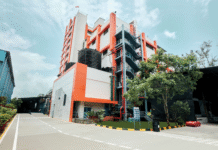The journey to Mumbai went smoothly. Now, the multi-function press 1-TBR Compact from HC Moog is about to reach the best stage of its journey from Ruedesheim to Hyderabad. There, it will supplement the impressive machine fleet of Pragati Pack from May 2016 onwards.
Although the new all-in-one machine from HC Moog is just one of the many machines of Pragati Pack, CEO Hemanth Paruchuri thinks that it holds a special position. “I had this investment on my mind ever since we visited an Open House of Moog in 2010,” he explains. For cost reasons, however, the company bought a comparable machine from China – and had to learn the lesson that comparability at best existed on paper. The technology did not deliver what the manufacturer had promised. Paruchuri decided to sell that machine and to buy the Moog 1-TBR Compact.
From technology ‘Made in Germany,’ Pragati Pack not only expects to get maximum quality, reliability and durability – but, above all, the ability to produce packaging solutions of even higher quality for customers from all over the world. The 1-TBR Compact is designed as a multi-functional printing, embossing and finishing press and turns even the most complicated packaging designs into products with maximum precision. At the same time, its all-in-one concept ensures economic efficiency and freedom of design.
Printing, embossing and finishing
The printing method used is sheetfed gravure printing which allows image resolutions of up to 10,160 DPI in combination with laser-exposed photopolymer printing plates. Such resolutions even enable to apply ‘hidden images’ on packages as integrated counterfeit protection. In addition, conventional, globally available printing cylinders can be used. The 1-TBR Compact combines this high print quality with flexible finishing processes – it is possible to use metallic pigments and pearlescent inks, to use glossy and matt coatings, functional coatings as well special haptic effect coatings.
In conjunction with the integrated embossing technology, the modular machine produces packages with an elegant look that attract customers at the point-of-sale and fascinate by their fine play of light on the printed and embossed surfaces. High-precision decorative and 3D embossing can be produced as easily as security and micro-embossed elements. Dryer modules based on infra-red, hot air or UV technologies supplement the multi-function concept. Due to the precise ink metering and high ink variability, the drying process can be fine-tuned to the individual job. This saves energy and contributes to the economic efficiency of the press, which is additionally supported by the minimized start-up waste in sheetfed printing.
“As soon as the press arrives in Hyderabad, a team from Moog will fly there and accompany the commissioning of the machine,” explains Achim Kurreck, CEO of HC Moog. The future press operators will be given training for their new press on site and will also be supported in the execution of the first orders. Pragati will be present at Hall 3 Stand A35 at drupa.
Packaging South Asia is the cooperating media partner for drupa 2016 which is scheduled to be held from 31 May to 10 June at Dusseldorf, Germany.











